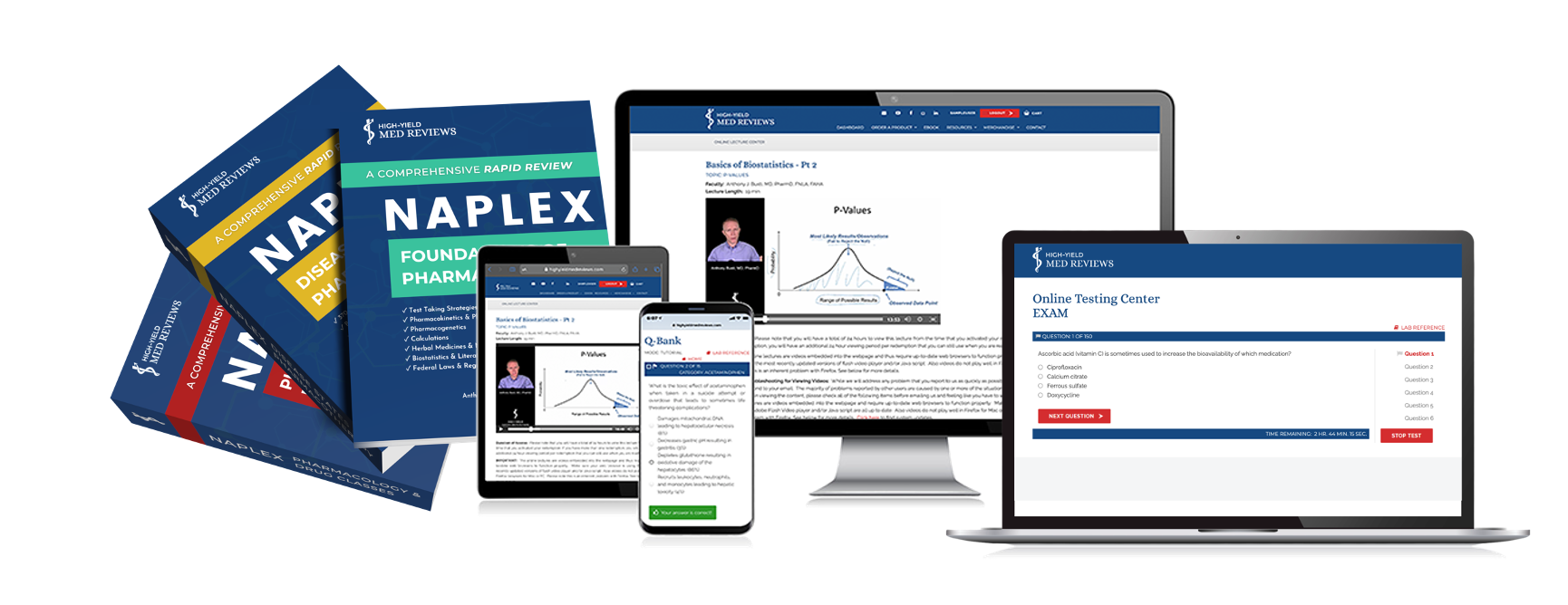What's on the NAPLEX Exam?
You are nearly at the finish line. After years of hard work, you are ready to begin your career as a practicing pharmacist. One final hurdle stands between you and the next phase of your career - the NAPLEX exam. Knowing what to expect and how to properly prepare is an essential first step to tackling the NAPLEX exam.
We listen to our pharmacy students, and they often share a common misconception. Diagnostic and clinical application of information is the job of the physician, not the pharmacist. This belief is based on misinformation and can, unfortunately, have disastrous consequences when it comes to the NAPLEX exam and clinical practice.
The NABP NAPLEX Competency Statements outline, in detail, what you need to know. You may be surprised by the questions and content you will encounter. The NAPLEX exam does not simply test your knowledge of drug mechanisms, but requires you to be able to interpret diagnoses, participate in evidence-based practice, and more. The focus of this exam is about therapeutic application for the care of the patient and preparing you to be a vital part of the patient care team. Read below for a detailed outline of what to expect.
The High-Yield Approach to NAPLEX Success

If you need a preparation package that follows the blueprint and equips you with core information and a proven method for how to apply it to complex clinical application questions, check out our NAPLEX Premium Package. It has everything you need to pass the NAPLEX exam on your first try. We stand behind our approach with a money-back pass guarantee because it works. Our 225-Question Practice NAPLEX Exam is designed to the NABP Blueprint and will help you gauge your readiness for this critical exam.
What to expect on the NAPLEX exam
The NAPLEX is a six-hour exam composed of 225 questions delivered in a computerized, fixed form. The exam results will be reported as pass or fail.
~18% OF TEST:
OBTAIN, INTERPRET OR ASSESS DATA, MEDICAL, OR PATIENT INFORMATION
- From instruments, screening tools, laboratory, genomic or genetic information, or diagnostic findings
- From patients: treatment adherence, or medication-taking behavior; chief complaint, medication history, medical history, family history, social history, lifestyle habits, socioeconomic background
- From practitioners: treatment adherence, or medication-taking behavior; chief complaint, medication history, medical history, family history, social history, lifestyle habits, socioeconomic background
- Signs or symptoms of medical conditions, healthy physiology, etiology of diseases, or pathophysiology
- From medical records: treatment adherence, or medication-taking behavior, chief complaint, medication history, medical history, family history, social history, lifestyle habits, socioeconomic background
- Risk factors or maintenance of health and wellness
- Evidence-based literature or studies using primary, secondary, and tertiary references
~14% OF TEST:
IDENTIFY DRUG CHARACTERISTICS
- Pharmacology, mechanism of action, or therapeutic class
- Commercial availability; prescription or non-prescription status; brand, generic, or biosimilar names; physical descriptions; or how supplied
- Boxed warnings or REMS
- Pregnancy or lactation
~35% OF TEST:
DEVELOP OR MANAGE TREATMENT PLANS
- Triage or medical referral
- Therapeutic goals or outcomes and clinical endpoints
- Medication reconciliation; indication or therapeutic uses; lack of indication; inappropriate indication; duplication of therapy; omissions
- Drug dosing or dosing adjustments; duration of therapy
- Drug route of administration, dosage forms, or delivery systems
- Drug contraindications, allergies, or precautions
- Adverse drug effects, toxicology, or overdose
- Drug interactions
- Therapeutic monitoring parameters, monitoring techniques, monitoring tools, or monitoring frequency
- Drug pharmacokinetics or pharmacodynamics
- Evidence-based practice
- Non-drug therapy: lifestyle, self-care, first-aid, complementary and alternative medicine, or medical equipment
~14% OF TEST:
PERFORM CALCULATIONS
- Patient parameters or laboratory measures
- Quantities of drugs to be dispensed or administered
- Rates of administration
- Dose conversions
- Drug concentrations, ratio strengths, osmolarity, osmolality, or extent of ionization
- Quantities of drugs or ingredients to be compounded
- Nutritional needs and the content of nutrient sources
- Biostatistics, epidemiological, or pharmacoeconomic measures
- Pharmacokinetic parameters
~11% OF TEST:
COMPOUND, DISPENSE, OR ADMINISTER DRUGS, OR MANAGE DELIVERY SYSTEMS
- Physicochemical properties of drug products affecting compatibility, stability, delivery, absorption, onset, duration, distribution, metabolism, or elimination
- Techniques, procedures, or equipment for hazardous or non-hazardous sterile products
- Techniques, procedures, or equipment for hazardous or non-hazardous non-sterile products
- Equipment or delivery systems
- Instructions or techniques for drug administration
- Packaging, storage, handling, or disposal
~7% OF TEST:
DEVELOP OR MANAGE PRACTICE OF MEDICATION USE SYSTEMS TO ENSURE SAFETY AND QUALITY
- Interdisciplinary practice, collaborative practice, or expanded practice responsibilities
- Continuity of care or transitions of care
- Disease prevention or screening programs; or stewardship
- Vulnerable populations, special populations, or risk prevention programs
- Pharmacy informatics
*Source: NABP
Start today and be ready for success on the NAPLEX Exam
Don't risk delaying your career. Start preparing now with a comprehensive NAPLEX preparation course that is designed to meet the rigorous demands of the NAPLEX Blueprint. At High-Yield, we have you covered!

Check out our NAPLEX resources.
Join our free NAPLEX Study Group and Community Forum.
You might also like: Knowledge Transfer Explained
The educational approach for higher-level understanding and application for exam success and clinical excellence.


